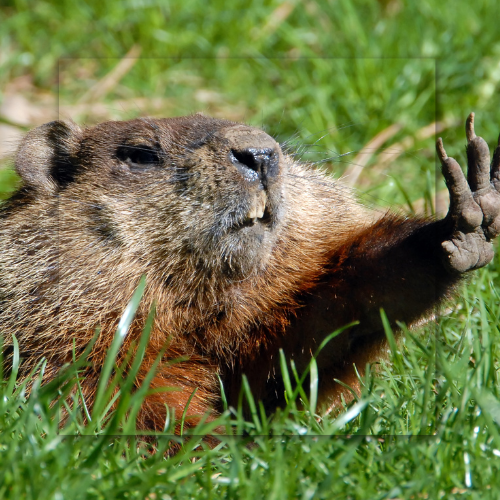
Groundhog Removal And Control
At Grade A Critter, we are committed to tackling your wildlife issues in the North Atlanta area. Today, we shine a spotlight on a critter that's often seen but frequently misunderstood—the Eastern Woodchuck, a subspecies of groundhog. Though some people might be charmed by the sight of these pudgy, waddling animals, they laundry list of problems they can create makes them far from adorable.
The Problematic Eastern Woodchuck
In our area, the Eastern Woodchuck is the common variety of this pest. With a brownish-gray coat and rotund appearance, it can seem innocuous enough. However, the nuisance it causes is multifold. This animal has a particular talent for digging elaborate tunnel systems that can stretch up to 45 feet in length. Imagine a small-scale subway system running underneath your property. These tunnels not only mar your lawn but can also compromise the stability of man-made structures like decks, patios, and even the foundation of your home.
But the disruption doesn't end there. Your lush vegetable garden and those carefully chosen ornamental plants? They can become a feast for these voracious eaters. Furthermore, these tunnels often become a hospitable environment for other pests, such as rats and venomous snakes, leading to a cascading series of problems.
Confronted with this unwelcome guest, many homeowners often turn to DIY solutions. The internet is full of advice—using repellents, deploying live traps, or applying fumigants. While these might sound like quick fixes, they seldom deliver long-lasting solutions.
Firstly, Eastern Woodchucks are more intelligent than they appear. They can evade poorly set traps and sometimes even learn how to trigger them without getting caught. Secondly, the use of chemicals and fumigants needs careful handling. Misapplication can endanger other wildlife, pets, and even humans. Plus, these chemicals can leach into soil and water supplies, posing broader environmental risks.
Some Facts That May Surprise You
Though primarily a nuisance, the Eastern Woodchuck also exhibits some fascinating behaviors. Ever wonder why they're always gnawing on something? Their teeth grow continually, and this gnawing action helps to keep their dental health in check.
Moreover, they don't just feed on plant matter. Contrary to popular belief, these animals are opportunistic eaters and will consume small insects and grubs. While they may be clearing some pests from your garden, they are also likely feasting on the plants you've worked hard to cultivate.
If you think your encounter with this pest is an isolated event, think again. Financial losses stemming from wildlife-related property damage run into hundreds of millions of dollars each year across the United States.
Call In The Professionals
In a world where experience and expertise matter, Grade A Critter stands tall. Our seasoned professionals are trained in the most current, humane, and effective methods of pest removal. We offer a comprehensive package that includes not just removing the nuisance but also ensuring they don't return. Our methods are environmentally responsible, ensuring the safety of your family and pets.
The service doesn't stop at removal. We assess your property to understand how these animals are gaining access in the first place. After identifying these points, we create barriers to prevent future infestations. It's not just about tackling the problem; it's about providing a holistic solution that brings long-term peace of mind.
In summary, dealing with this pervasive pest is not a task for the untrained. Ineffective solutions can exacerbate the problem and even pose new risks. At our company, we have the tools, the technology, and the know-how to deal with these nuisances effectively and humanely.
For a free consultation and to learn how we can help you reclaim your space from these disruptive animals, feel free to contact us today. Trust us; your garden, your home, and your peace of mind will be better for it.
Frequently Asked Questions
Q1: Can These Animals Transmit Diseases to Humans or Pets?
A1: While the pest is not commonly associated with transmitting diseases like rabies or Lyme disease, it's important to note that their burrows can become breeding grounds for ticks and fleas. These parasites, in turn, can carry diseases that may affect humans and pets. Additionally, the animal's feces and urine can contaminate soil and water, posing indirect health risks. Therefore, while direct disease transmission is relatively rare, the presence of this nuisance in your property can still have health implications that shouldn't be overlooked.
Q2: Do Eastern Woodchucks Display Any Form of Social Structure or Hierarchy Within Their Burrows?
A2: While many may assume that these animals lead solitary lives, some research indicates that there might be a form of social structure or even a rudimentary hierarchy within their burrows. For instance, it's been observed that multiple individuals might share a tunnel system, especially during the colder months for hibernation. However, this social behavior isn't well-understood and could complicate efforts to remove these nuisances from your property. One individual's removal might not deter others from continuing to reside in the existing tunnels, making professional intervention all the more critical.
Q3: How Do Eastern Woodchucks React to Ground Vibrations or Noise? Can This Be Used as a Deterrent?
A3: While many believe that loud noises or vibrations can act as a deterrent for these pests, the truth is more nuanced. Eastern Woodchucks have a keen sense of their environment and may initially be startled by such disruptions. However, they often acclimate to these sensations over time, making it an unreliable long-term strategy for keeping them at bay. Furthermore, any initial success in using sound or vibrations to deter them might give homeowners a false sense of security, leading to prolonged infestation and increased damage to property.
Grade A Critter
